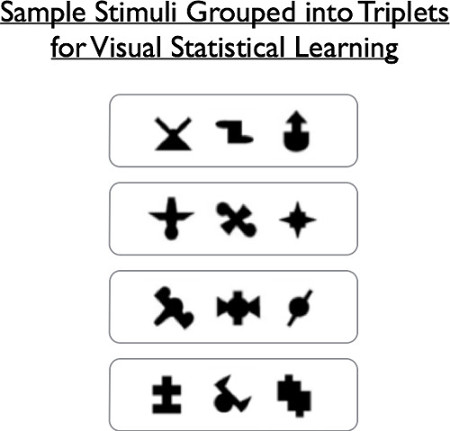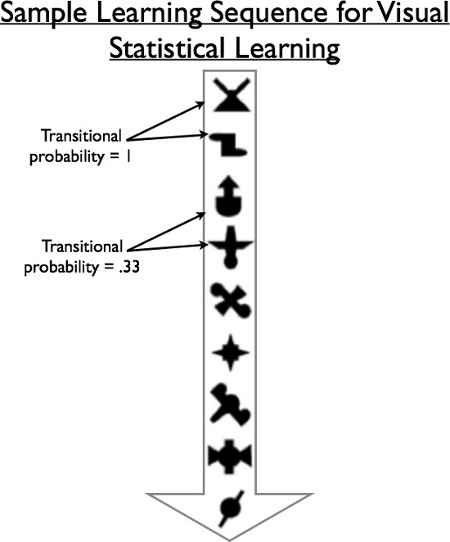1. Generate a set of nonsense objects and arrange them into a triplet structure.
- Often visual statistical learning is studied with simple objects like the set below. Generate a set of objects, and then group them into triplets (Figure 1).

Figure 1. Sample stimuli grouped into triplets for visual statistical learning. In the learning segment of an experiment, triplets will appear in random order, but the items within a triplet will always appear in order, with the item on the left appearing first followed successively by the items to its right.
2. Sequence the experiment.
- Sequence the experiment with software such as e-Prime, or by using a routine library such as Psychophysics Toolbox in MATLAB, or PsycoPy for Python.
- The nonsense objects are displayed in the center of the screen, one-at-a-time, for 250 ms each.
- Instruct the program to always show members of a triplet in sequence, and to choose which triplet to show next randomly, ending up with sequences similar to Figure 2.

Figure 2. Sample learning sequence for visual statistical learning. The triplets appear in a random order such that the transitional probability for items in different sequences is about 0.33, while the transitional probability within a sequence is 1.
- Note that because triplets always appear in sequence, the transitional probability between elements of a triplet is always 1. But because transitions between triplets are selected randomly, transitional probabilities between unrelated elements are considerably lower, usually contrived to be about 0.33.
- Finally, build in a cover task. Instruct the program to render one of the objects in RED, as opposed to gray. The program will do this about 20 times over the course of a 10-min experiment, selecting the moments randomly. The participant’s task will be to press a key whenever an object is shown in gray, but to withhold a response whenever it is red. This will keep them engaged in the stimuli.
3. Familiarity test
- Write a separate program for the familiarity test. On each trial of the test, the program randomly selects one of the actual triplets, and it randomly generates a new triplet from the constituents of the actual triplets. These randomly generated triplets are called ‘foils.’
- They are displayed side-by side, and the participant needs to indicate which is more familiar by a key press.
- The experiment should include about 30 familiarity test trials.
- The instructions for the familiarity test are important. They must include something like this: “I’d like you to do one more task before the experiment is over. It should only take five minutes. You probably did not notice it, but in the sequence of shapes you just saw, some shapes were more likely to appear following others. I’ll now show you two sets of shapes from the experiment, and you need to just press the 1-key or the 2-key to let me know which grouping looks more familiar to you. You may not feel that you recognize either. In all trials, I want you to just go with your gut and to guess if you have to.”
Learning regularities-the statistical structures of objects in our external world-is an important part of visual processing.
Objects in our visual environment occur in the dimensions of space and time. Certain objects are more likely to appear near others, like a coffee cup next to a computer.
Such occurrences provide regularities that support predictable object recognition, in which humans learn automatically and quickly, without conscious awareness.
This video demonstrates how to setup and conduct a visual statistical learning experiment using an incidental encoding paradigm, as well as how to analyze the data and interpret the results.
In this experiment, the stimuli-sets of nonsense objects grouped into triplets-are displayed on the center of a computer screen, one at a time, for 250 ms each.
To establish regularities-the statistical structure-the objects within a triplet are always shown in the same sequence, but the order of triplets is presented at random.
Thus, the transitional probability between elements of a given triplet is always 1, whereas the transitional probabilities between unrelated elements are considerably lower.
In order to unknowingly expose participants to the object sequences, a cover task is used with colored objects. In this case, participants are asked to make a response when the objects are gray and to withhold when the objects randomly appear red.
After the cover task is completed, participants are given a familiarity task to test the extent of encoding the previous nonsense objects. During each familiarity trial, previously viewed triplets are randomly presented along with newly generated triplets, referred to as foils.
Now, participants are asked to identify which set is more familiar. The dependent variable then is the number of times participants correctly identify the prior triplets as most familiar, rather than the foils.
If no learning occurs during the initial encoding phase, the actual and foil triplets would be picked the same number of times. On the other hand, if learning occurred, the actual triplets will be picked more frequently than the foils.
Before the participant arrives, verify that the stimuli and coding parameters to be used have been generated.
To begin the experiment, greet the participant in the lab and explain the general procedures that will be used for the task.
Have the participant sit comfortably in front of the computer monitor and keyboard. Explain that when a gray object appears on the screen they should press the 'J' key, and when red objects appear they should withhold responses.
Once the participant understands the task rules, start the first portion of the experiment, the incidental encoding phase. Expose the participants to the object sequences for 10 min.
After the short exposure period, explain that there is one more task to complete in a 5 min period. Instruct the participant that they will now see two sets of triplets and should press the 1-key or the 2-key to indicate which grouping looks more familiar. Tell them that they should guess if they don't recognize either.
After confirming that the participant is ready to begin, start the 30 familiarity trials.
To analyze the data in the familiarity phase, score each trial where the participant chose the familiar triplet as correct and the foil triplet as incorrect.
To visualize the results, graph the mean of the percent correct responses across participants. Because chance performance is 50%, note that visual statistical learning occurred, as participants correctly identified the familiar objects around 70% of the time.
Now that you are familiar with the methods of inducing and testing visual statistical learning, let's take a look at other ways experimental psychologists use statistics to investigate learning.
The paradigm can be translated into broader classes of sensory learning mechanisms that include the auditory domain. For example, infants and children use auditory statistics in early language formation because the sounds and letters in a language tend to appear with highly reliable statistical relationships.
In another experiment, researchers investigated how the associations between letters and colors can be unknowingly or implicitly learned. Over several days, participants read texts that were customized to have four distinctly colored letters.
When asked to identify the color of letters presented on a screen, participants were faster and more accurate for letter-color pairs that were the same as in the customized text. This suggests that the statistical structure of the colored letters was implicitly learned.
You've just watched JoVE's introduction to visual statistical learning. Now you should have a good understanding of how to setup and perform the experiment, as well as analyze and assess the results.
Thanks for watching!
















